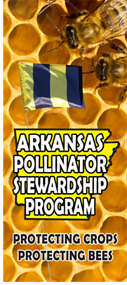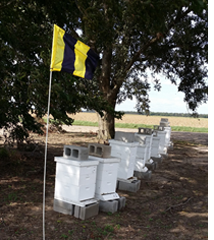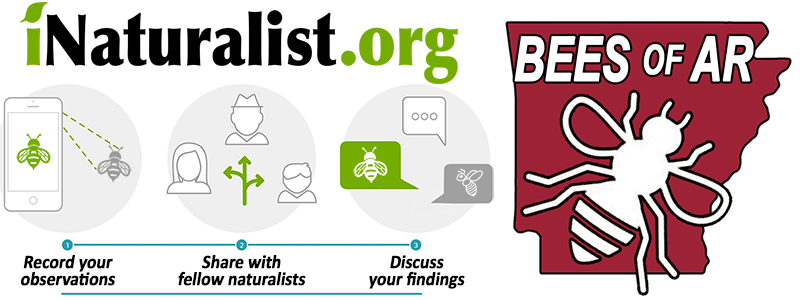Contact
Assistant Professor of Apiculture & Urban Entomology
Phone: 501-671-2222
Fax: 501-671-2252
Email: jzawislak@uada.edu
Web: uaex.uada.edu/bees
University of Arkansas System
Division of Agriculture
Cooperative Extension Service
2601 N. Young Ave.
Fayetteville, AR 72704
The Importance of Pollinators
Why pollinators are important
Pollination is the transfer of pollen, containing the male gamete of a plant, from the anthers where it is produced to the receptive stigma, the female part of the same or another plant of the same species. This process results in fertilization, and sexual reproduction of the plant to produce seeds.
Most ancient plants were pollinated by wind. Grasses, conifers, and many deciduous trees are still wind-pollinated. Most flowering plants, however, utilize living organisms to aid in this transfer. Birds and bats can pollinate a limited number of plants, but the vast majority of plants are pollinated by insects. Some wasps, flies, beetles, ants, butterflies and moths pollinate various flowers, but bees are responsible for the vast majority of pollination.
Honey bees perform more than 80 percent of pollination of many of our cultivated crops.
More than 100 important crops are pollinated by honey bees. This includes many of the fruits and vegetables that we eat, but also a number of important crops such as nuts, herbs, spices oilseed crops, forage for dairy and beef cattle, as well as medicinal and numerous ornamental plants. Even plants that are not grown for their fruits require pollination in order to propagate them by seed. Honey bees add an estimated $15 billion to the U.S. economy each year in increased crop yields.
Many species of pollinators have been in decline recently. Why?
European honey bees were brought to North America by colonists in the 1600s. As many of these bees escaped into the wild, the feral populations began to displace some of the estimated 4000 native bee species. These feral honey bees provided pollination for the growing agricultural industry across the county through the 20th century. In the 1990s two species of parasitic mites were accidentally introduced from Asia. The tracheal mite and varroa mite caused severe declines in honey bee populations within a few years. These parasitic mites were controlled on managed bees largely with chemical pesticides, substantially increasing the costs of large beekeeping operations.
During the same time, populations of feral honey bees dramatically declined. Fewer natural pollinators, combined with increased agricultural production have resulted in an increased need for contracted pollination services. Honey bee hives are placed on trucks each spring and moved from their winter homes to areas of agricultural production in order to provide adequate numbers of pollinators when crops are in bloom. This movement of honey bee hives is thought to be associated with the spread of honey bee diseases and other hive pests.
Colony Collapse Disorder (CCD)
During the winter of 2006-2007, a high number of bee colonies died out, but the cause of death remained a mystery. The next winter, colonies died out at even higher rates. The phenomenon was termed Colony Collapse Disorder, or CCD, and has been reported in Europe as well as the U.S. This mysterious disappearance of honey bees raised alarms that we may be on the verge of a pollinator crisis, resulting in insufficient numbers of pollinators to supply the demands of our agricultural industry. This pollinator shortage is not likely to result in a large-scale food shortage in the US. However, there may be an increase in the cost of some produce because of the increase in production costs associated with the demand of pollinators.
Many of our fruits and vegetables are imported from Asia and Latin America, where CCD has not been largely reported. Most staple food crops, such as wheat, rice and corn, are wind-pollinated. Other crops, such as soybeans, are self-fertile, and are not dependent upon pollinators. And some crops, such as peaches and cotton, can self-pollinate, but when pollinated by bees tend to produce larger yields.
Protecting PollinatorsIn light of declining honey bee populations worldwide, representatives of Arkansas’ agricultural producers and beekeepers have develop a set of standard practices to encourage cooperation and communication between growers, pesticide applicators, and beekeepers. The goals of the Arkansas Pollinator Stewardship Program are to minimize economic losses for both farmers and beekeepers by adequately managing row crop pests while minimizing impact of pesticides on honey bee colonies. |
 |
 |
Some Important Crops Pollinated by Bees
| Fruits and Vegetables | |||
|---|---|---|---|
| Apple | Cherry | Kiwi | Persimmon |
| Apricot | Chicory | Leek | Pimento |
| Artichoke | Citron | Lemon | Plum |
| Asparagus | Collards | Lima beans | Pummelo |
| Avocado | Cranberry | Lime | Pumpkin |
| Blackberry | Cucumber | Mango | Radish |
| Blueberry | Currants | Muskmelon | Raspberry |
| Broccoli | Dewberry | Nectarine | Rutabaga |
| Brussels sprouts | Eggplant | Onion | Squash |
| Cabbage | Gooseberry | Orange | Strawberry |
| Cantaloupe | Grapefruit | Passion Fruit | Tangerine |
| Carrots | Honeydew | Peach | Turnip |
| Cauliflower | Huckleberry | Pear | Watermelon |
| Celery | Kale | Peppers | Zucchini |
| Nuts | |||
|---|---|---|---|
| Almond | Cashew | Chestnut | Coconut |
| Coffee | Kola | Macadamia | |
| Herbs and Spices | |||
|---|---|---|---|
| Basil | Coriander | Garlic | Nutmeg |
| Chives | Dill | Mint | Oregano |
| Cinnamon | Fennel | Mustard | Parley |
| Livestock Forage | |||
|---|---|---|---|
| Alfalfa | Buckwheat | Clover | Vetches |
| Oil Crops | |||
|---|---|---|---|
| Canola | Palm Seed | Sesame | Sunflower |
| Cotton Seed | Safflower | Soybeans | Tung |
Planting to Attract Pollinators
Many species of pollinators are in decline around the world due to destruction of natural habitat. This is especially true in industrialized countries such as the U.S. Bees and other pollinators are a vital part of the natural system. Besides humans, many other species rely on pollinators. Plants need pollination in order to reproduce, and many species of wildlife depend on pollination in order to find their food as well. Gardeners and homeowners can plant a variety of trees, shrubs, and flowers to attract pollinators. By choosing a variety of flowers that provide blooms continuously throughout the growing season, you can ensure that pollinators will return regularly. Find out what to plant in your region by visiting the Pollinator Partnership.
Encouraging Native Pollinators
Becoming a backyard beekeeper is a great way to increase the pollinator population in your neighborhood. If you don't want to keep honey bees, encouraging native pollinator species can be very simple. Many species of solitary bees are native to Arkansas. These bees will rarely, if ever, sting. They do not require sophisticated hives or other equipment to maintain. By providing them with simple habitats from scrap wood, you can increase the productivity of your garden.
Help With a Citizen-Scientist Survey of Native Bees in Arkansas
Over many years, The University of Arkansas Arthropod Museum has documented over 200 species of native bees, collected from across the Natural State. Unfortunately, however, most native bees have remained largely understudied groups around the world. Historically most bee species have never been considered economically important compared to their famous cousins, the honey bees. Recent studies have broadened our understanding of the importance of native pollinators and their contributions to both native plant ecosystems and cultivated crop yields. However, most native bee studies are limited in scope to specific areas that scientists can access for extended periods of time. Now citizen scientists can help.
The iNaturalist organization is a volunteer group of amateur and professional naturalists - nature lovers - who are working to document the diversity of life everywhere around them. And you can be part of it! To get started, just can visit the iNaturalist.org website or download their smartphone app (for Android or Apple) and set up a new user account. Now start snapping photos of any living thing you see: insect, spider, bird, snake, mammal, or even a plant or mushroom.
If you use a regular camera, you can upload your images through their website, but your smartphone's camera can automatically record the date and location of each image, and you can upload these observations to the database with notes about what you saw. If you can identify the species, you can add it's name. But even if you don't know for sure, just put in as much information as you can, or your best guess. Other users across the globe can help refine the identification until a consensus has been reached. Many professional taxonomists and biologists participate, so there is a good chance your photo may be seen by an expert.
Observations can also be grouped into specific projects such as the Arkansas Native Bee Survey. Any image identified as a species of bee reported in Arkansas, will be added to this project. This will expand our knowledge of native bee species abundance and their distribution throughout our state. Other projects exist to curate observations on snakes, birds, spiders and even track the migration route of the declining monarch butterfly. This information can be used to help scientists locate previously unknown populations of threatened or endangered species. The data collected can document that a particular species has a larger range than previously known, or a lack of observations over time may suggest that a species could be be disappearing from an area. A single casual observation from a curious user might even alert scientists to the presence of a new invasive species.
Begin by documenting your own back yard. Take photos whenever and wherever you go out. All citizens are encouraged to participate. This can be a great project for schools, scouts, and other groups of nature lovers. Help add to our knowledge of the world and join today.
Additional information on encouraging solitary bees
- USDA Guide to Preparing a Solitary Bee Nesting Block
- NCSU Guide to Managing Orchard Mason Bees
- Attracting Solitary Bees
- The bee family Megachilidae
Video clips about solitary bees
- How to Make a Mason Bee Block
- Mason Bees Coming to Life
- Solitary Bees Provisioning their Nesting Holes
- How to Attract Leafcutter and Mason Bees
- Bee Houses: Nest Holes for Solitary Bees
